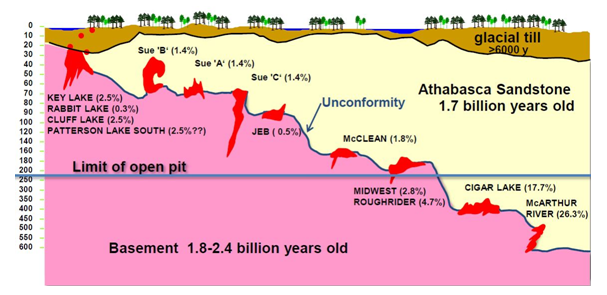Athabasca Basin Uranium prices were weak after
Post# of 579

Uranium prices were weak after the early post war demand subsided. It wasn’t until the mid 1960’s prices improved and exploration increased.
The Athabasca Basin is an ancient sedimentary basin located along the Northern Alberta-Saskatchewan border south of Lake Athabasca. The Basin covers approximately 100,000 square kilometers in Saskatchewan and a small portion of Alberta. With the Port Radium area thoroughly explored a consortium flew an airborne radiometric survey over the sandstones of the Basin in 1967.
Follow up on the survey resulted in the discovery of the Rabbit Lake mine in 1968.
The “Athabasca Basin” legend was born resulting in a huge staking rush by juniors and in particular large multinational oil companies. This was the beginning of a prolific period of ongoing uranium discoveries incomparable to any other domain in the world.
When the Cluff Lake D Zone was found in 1969, the Athabasca Basin become host of the highest grade uranium deposit ever found up that time.
In 1975, the richest open-pit deposit in the world was discovered at Key Lake.
More than 15 uranium deposits totaling over 1.4 billion pounds of uranium have been discovered in the region since the Rabbit Lake mine discovery back in 1968
Today the Athabasca Basin of northern Saskatchewan hosts the world’s largest and richest high-grade uranium deposits accounting for approximately 15 percent of global primary uranium supply.
Athabasca uranium deposits have grades substantially higher than the world average grade of about 0.1% U3O8. The two dozen or so known uranium deposits within the Athabasca Basin have average grades of more than 3.0% U3O8.
Unconformity-related deposits
One thing almost all economic uranium deposits have in common is that the uranium is remobilized from one area and re-precipitated in a host rock where chemical conditions are conducive to concentrating the uranium in higher concentrations.
An unconformity is a time gap in the rock record between two rock units. The lower unit may be deformed, brecciated or altered while the overlying units are less deformed. Uranium deposits occur in both the underlying and overlying units.
In the underlying units, there may be a weathering zone, fault zone or some other feature that increases the rocks porosity and permeability. In the overlying units, it may be the sandstones or some other features that allows the concentration of uranium.
The deposits in the Athabasca Basin can occur below, across and immediately above the unconformity, with the highest grade deposits situated at or just above the unconformity (eg Cigar Lake and McArthur River).
The initial discoveries were found through surface indicators - radioactive boulders, geochemical anomalies in the surrounding lakes and swamps and geophysical signatures. Hydrothermal fluids associated with high grade uranium deposits will cause extensive alteration of the host rock, resulting in displacement and removal of minerals/elements, creating porosity and subsequent density contrast. This density contrast will be expressed as a gravity low anomaly and is a prime drill target when qualified by other coincident indicators of uranium mineralization such as geochemistry and radon.
Today, all of Canada's uranium production is from unconformity-related deposits - Key Lake, Cluff Lake, Rabbit Lake (Cluff Lake, Key Lake and the original open pit at Rabbit Lake have now been mined out, underground mining continues at Rabbit Lake), and McClean Lake and McArthur River deposits. Other large, exceptionally high grade unconformity-related deposits currently being developed include Cigar Lake (averaging almost 20% U3O8, some zones over 50% U3O8).
 (0)
(0) (0)
(0)